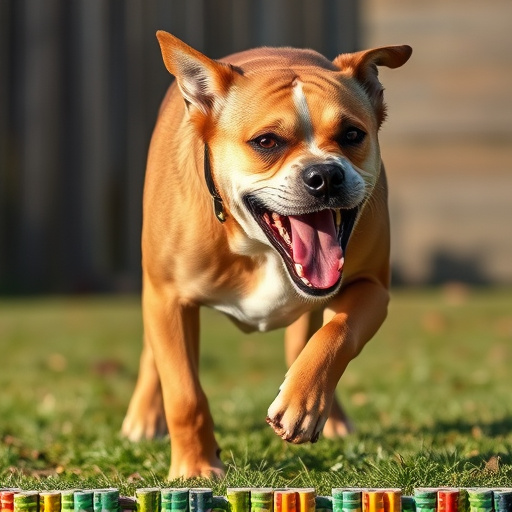Dogs' powerful sense of smell can be leveraged with Dog Repellent Spray training exercises to teach them which odors to avoid, using capsaicin-based spray under professional guidance. This method associates unpleasant experiences with specific scents, enhancing their responsiveness outdoors. A well-designed dog repellent spray should be portable, odorless, and easy to use, promoting positive training practices without harming dogs. Through gradual introduction and positive reinforcement, dogs can learn to accept the spray favorably, ready to respond quickly in various situations.
Discover the power of compact animal repellent pepper spray, an innovative solution for managing canine behavior. This comprehensive guide explores dog repellent sprays, delving into their effectiveness against unwanted behaviors. We’ll demystify dog senses, understanding how scent plays a key role in training. Learn about the science behind pepper spray repellents and their design as a convenient, portable tool. Additionally, explore effective training exercises utilizing positive reinforcement to ensure safe and successful integration of this game-changing product for folks navigating their pet’s behavior.
- Understanding Dog Behavior and Their Sense of Smell
- The Science Behind Pepper Spray as a Repellent
- Designing a Compact Dog Repellent Spray: Features and Benefits
- Training Exercises for Effective Use and Positive Reinforcement
Understanding Dog Behavior and Their Sense of Smell
Dogs, like humans, have a powerful sense of smell that plays a crucial role in their behavior and communication. Understanding this sense is key to creating effective dog repellent strategies. Training exercises centered around scent recognition can be an excellent way to teach dogs what odors they should avoid or associate with certain outcomes.
By introducing Dog Repellent Spray during training sessions, you can condition your canine companion to respond negatively to specific scents. This method leverages their keen olfaction and natural instinct to avoid unpleasant experiences, making it a highly effective approach in repelling unwanted dog behavior.
The Science Behind Pepper Spray as a Repellent
Pepper spray, a compound derived from chili peppers, has gained popularity as an animal repellent due to its unique properties. When applied to an animal’s eyes and skin, it triggers a burning sensation and temporary blindness, making it an effective deterrent for dogs, cats, and other wildlife. The science behind its effectiveness lies in capsaicin, the active ingredient that stimulates nerve endings, causing the body’s natural response to neutralize the irritant. This instant reaction can train animals to associate certain areas or objects with discomfort, deterring them from approaching.
In the context of dog repellent spray training exercises, pepper spray can be a useful tool. By applying the spray during specific training sessions, dogs can learn to avoid certain areas or behaviors. These exercises should be conducted responsibly and under professional guidance to ensure the safety and well-being of both the animal and the trainer. With consistent practice, dogs can develop an innate understanding of the scent and its associated discomfort, making them more responsive to the spray’s repellent effect during outdoor activities or in unfamiliar environments.
Designing a Compact Dog Repellent Spray: Features and Benefits
When designing a compact dog repellent spray, the primary focus should be on creating an effective yet user-friendly product. Key features include a fine mist nozzle for precise application, a powerful yet safe formula that deters dogs without harming them, and a portable size that fits comfortably in your hand or pocket. The spray should also be odorless to avoid confusing or upsetting the targeted dog, ensuring clear communication during training exercises.
Benefits of such a design extend beyond convenience. A compact format allows for easy carrying, making it ideal for outdoor activities where dogs might approach. The ability to quickly deploy the spray can help manage and control unwanted canine interactions, especially in areas where traditional barriers are impractical or impossible to install. Moreover, the non-harmful formula encourages positive training practices, enabling dog owners to incorporate this repellent into their routine exercises to teach their pets appropriate behavior.
Training Exercises for Effective Use and Positive Reinforcement
Training your dog to accept and respond positively to pepper spray is crucial for its effective use as a dog repellent. Start with simple, short sessions in a controlled environment, introducing the spray’s scent and sound gradually. Reward calm behavior with treats and praise to reinforce that remaining still and quiet is beneficial. It’s important to note that consistency and patience are key; regular practice will help your dog associate the spray with positive outcomes rather than fear or anxiety.
Use positive reinforcement techniques throughout training exercises for Dog Repellent Spray. Encourage your dog to approach and investigate the spray in a controlled manner, rewarding them for curiosity and bravery. Gradually increase the intensity of the scent and sound, always ending sessions on a positive note. Remember, the goal is to turn your dog into an enthusiastic participant rather than a reluctant observer; with proper training, they’ll be prepared to respond quickly and effectively when needed.
A compact dog repellent pepper spray can be an effective tool to manage unwanted canine interactions, but its success relies on proper understanding and training. By combining knowledge of dog behavior, the science behind pepper spray’s effectiveness, and implementing positive reinforcement during training exercises, owners can ensure their pet stays safe without resorting to aggressive actions. Remember, consistent practice and a well-trained pup will make this compact repellent an indispensable companion for peaceful walks in any environment.
